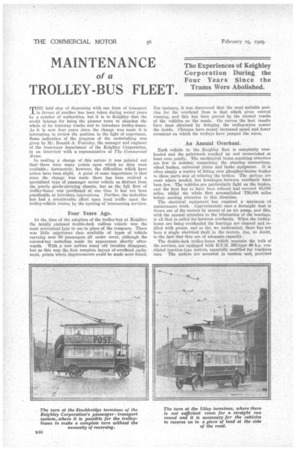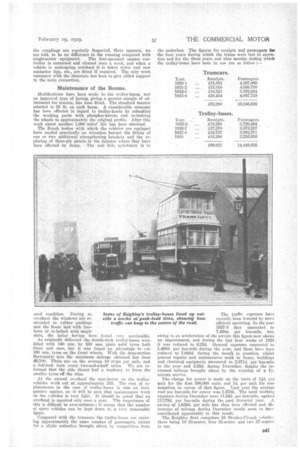MAINTENANCE
Page 146

Page 147

If you've noticed an error in this article please click here to report it so we can fix it.
of a
TROLLEY-BUS FLEET. Trams Were Abolished.
THE bold step of dispensing with one form of transport in favour of another has been taken during recent years by a number of authorities, but it is to Keighley that the credit belongs for being the pioneer town to abandon the whole of its tramway tracks and to introduce trolley-buses. As it is now four years since the change was made it is interesting to review the position in the light of experience. Some indication of the progress of the undertaking was given by Mr. Ronald A. Fearuley, the manager and engineer of the tramways department of the Keighley Corporation. in an interview with a representative of The Commercial Motor.
In making a change of this nature it was pointed out that' there were many points upon which no data were available ; fortunately, however, the difficulties which have arisen have been slight. A point of some importance is that since the change was made there has been evolved a specialized type of passenger motor vehicle as distinct from the purely goods-carrying chassis, but as the full fleet of trolley-buses was purchased at one time it has not been practicable to introduce innovations. Further, the motorbus has had a considerable effect upon local traffic upon the trolley-vehicle routes, by the opening of intersecting services.
Four Years Ago.
At the time of the adoption of the trolley-bus at Keighley the totally enclosed double-deck railless vehicle was the most convenient type to use in place of the tramcars. There was little experience then available of types of vehicle carrying over 50 passengers all under cover, although the covered-top motorbus made its appearance shortly afterwards. With a new service many old troubles disappear, but as this was the first complete layout of -overhead equipment, points where improvements could be made were found. For instance, it was discovered that the most suitable position for the overhead lines is that which gives central running, and this has been proved by the normal tracks of the vehicles on the roads. On curves the best results have been obtained by bringing the trolley-wires nearer the inside. Changes have meant increased speed awl fewer occasions on which the trolleys have jumped the wires.
An Annual Overhaul.
Each vehicle in the Keigbley fleet is completely overhauled and the paintwork touched up and revarnished at least once yearly. The mechanical items requiring attention are few in number, comprising the steering connections, wheel bushes, universal joints and brake equipment. It is often simply a matter of fitting new phosphor-bronze bushes to these parts and of refacing the brakes. The springs are reset where needed, but breakages between overhauls have been few. The vehicles are particularly light on the brakes, end the first bus to have been refaced had covered 65,000 miles, whilst the whole fleet accomplished 730,000 miles before needing attention in this direction.
The electrical equipment has required a minimum of maintenance work. Approximately once a fortnight dust is blown out of the motors by means of an air pump, and this, with the normal attention to the lubrication of the bearings, is all that is called for between overhauls. When the trolleybuses are being overhauled the bearings are cleaned and refilled with grease, and so far, we understand, there has not been a single electrical fault in the motors, due, no doubt, to the fact that they are of adequate capacity.
The double-deck trolley-buses which rnantain the bulk of the services, are equipped with B.T.H. 265-type 40 h.p. ventilated traction-type motors, especially modified for trackless ears. The motors are mounted in tandem and, provided
the couplings are regularly Inspected, there appears, we are told, to be no difference in the running compared with single-motor equipment. The foot-operated master controller is examined and cleaned once a week, and when a vehicle is undergoing Overhaul it is taken down and new contactor tips, etc., are fitted if required, The only work necessary with the rheostats has been to give added support to the main connection.
Maintenance of the Booms.
Modifications have been made to the trolley-bases, and an improved type of spring, giving a greater margin of adjustment for tension, has been fitted. The standard tension selected is 28 lb. on each boom. A considerable economy has been effected in regard to trolley-heads by rebushing the working parts with phosphor-bronze and re-turning the wheels to approximately the original profile. After this work about another 1,000 miles' life has been obtained.
The Brush bodies with which the vehicles are equipped have needed practically no attention beyond the fitting of one or two additional strengthening brackets and the replacing of three-ply panels in the interior where they have been affected by damp. The real hide upholstery is in
good condition. During an Some of Keighley's trol overhaul the windows are reside a works at peak-1 mounted in rubber packings traffic can keep to th
and the floors laid with lino leum or re-lathed with niapTh slats, the latter having been found very servieeable.
As originally delivered the double-deck trolley-buses were fitted with 140 rem. by 850 mm, plain solid tyres both front and rear, but it was found an advantage to t.se 160 tom. tyres on the front wheels. With the deep-section Sectoniatic tyre the maximum mileage obtained has been • 46,540. There are on the average 14 stops per mile, and a full-lock turn" every two-and-a-half miles. We are informed that the Side thrust had a tendency to force the smaller tyres off the rims.
At the annual overhaul the man-hours on the trolleyvehicles work out at approximately 335. The cost of replacements in the case of trolley-buses is also an inexpensive matter, so it will be seen that maintenance work on the vehicles is very light. It should be noted that an overhaul is required only once a year. The importance of this is difficult to over-estimate ; it means that the number of spare vehicles can be kept down to a very reasonable figure.
Compared with the tramcars the trolley-buses are carrying approximately the same number of passengers, except for a slight reduction brought about by competition from the motorbus. The figures for receipts and pasSengers few the four years during which the trams were last in operation and for the three years and nine months during which the trolley-buses have been in use are as follow :- The traffic expenses have recently been lowered by Mere efficient operating. In the Year 1927-8 they amounted to 7.464d. per bus-Mile, hut, owing to an acceleration of the service this figure now shows an improvement, and during the last four weeks of 1928 it was reduced to 6.22d. General expenses amounted to 1.466d, per bus-mile daring the year, and these have been reduced to 1088d. during the month in question, whilst general repairs and maintenance work to buses, buildings and electrical equipment amotinted to 2.371d. per bus-mile in the year and 2.28d. during December, despite the increased mileage brought about by the running of a 7minute service.
The charge for power is made on the basis of lid. rer unit for the first 300,000 units and ld per unit for consumption in excess of that figure. •Last year the average cost per bus:mile for power was 1.878d. The total working expenses during December were 11.54d. per bus-mile, against 13.179d. per bus-mile during the past financial year. A saving of 1.639d. per mile has thus • been effected and the increase of mileage during December would • seem to have contributed appreciably to this result.
The Keighley fleet comprises 16 Straker-Clough vehicles. there being 10 50-seater, four 32-seater and two 27-seaters in use. • fey-buses lined up outoad time, showing how e centre of the road.




























































































































































































































